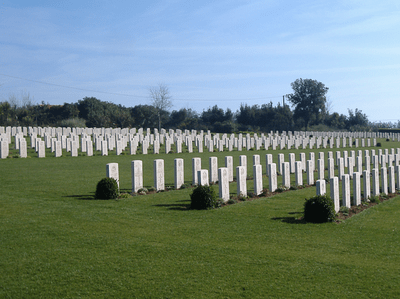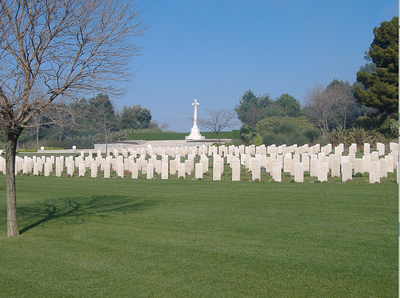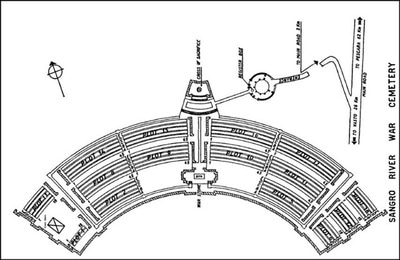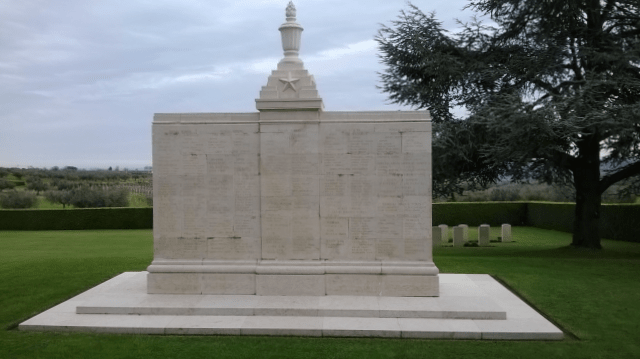SANGRO RIVER WAR CEMETERY AND CREMATION MEMORIAL
Chieti
Italy
Location Information
The Sangro River War Cemetery lies in the Contrada Sentinelle in the Commune of Torino di Sangro, Province of Chieti.
Take the autostrada A14 (the road that runs from Taranto in the south to Ancona in the north) and exit at Val di Sangro. After approximately 2.5 kilometres from the exit turn right onto the SS16, Pescara to Vasto road, for nearly 2 kilometres. There is then a sharp right turn up to cemetery.
If you come from the station, take a taxi from Torino di Sangro station, otherwise follow the road signs to SS16 (see direction), turn right at the crossroad and continue following the signs. The station is about 7 kilometres from the cemetery.
Cemetery address: Contrada Sentinelle s.n. - 66020 Torino di Sangro (CH) Abruzzo.
GPS Co-ordinates: Latitude: 42.218406, Longitude: 14.535594.
Visiting Information
The cemetery is permanently open and may be visited anytime. The cemetery main gate is kept locked outside of the gardeners working hours to prevent wild boars entering at night. The gate can be opened by entering the code 1221 on the combination padlock.
Wheelchair access to this site is possible via an alternative entrance.
Historical Information
On 3 September 1943 the Allies invaded the Italian mainland, the invasion coinciding with an armistice made with the Italians who then re-entered the war on the Allied side. Allied objectives were to draw German troops from the Russian front and more particularly from France, where an offensive was planned for the following year.
Progress through southern Italy was rapid despite stiff resistance, but by the end of October, the Allies were facing the German winter defensive position known as the Gustav Line, which stretched from the river Garigliano in the west to the Sangro in the east. By 4 November, the Allied force that had fought its way up the Adriatic coast was preparing to attack the Sangro river positions. A bridgehead had been established by the 24th and by nightfall on the 30th, the whole ridge overlooking the river was in Allied hands.
The site of this cemetery was selected by the 5th Corps and into it were brought the graves of men who had died in the fierce fighting on the Adriatic sector of the front in November-December 1943, and during the static period that followed. In addition, the cemetery contains the graves of a number of escaped prisoners of war who died while trying to reach the Allied lines.
SANGRO RIVER WAR CEMETERY contains 2,617 Commonwealth burials of the Second World War.
Within the cemetery will be found the SANGRO RIVER CREMATION MEMORIAL, one of three memorials erected in Italy to officers and men of the Indian forces whose remains were cremated in accordance with their faith - the other two cremation memorials are in Forli Indian Army War Cemetery and Rimini Gurkha War Cemetery. The memorial at Sangro River commemorates more than 500 servicemen.
Cemetery and Memorial pictures used with the permission of the Commonwealth War Graves Commission
The Sangro River War Cemetery lies in the Contrada Sentinelle in the Commune of Torino di Sangro, Province of Chieti.
Take the autostrada A14 (the road that runs from Taranto in the south to Ancona in the north) and exit at Val di Sangro. After approximately 2.5 kilometres from the exit turn right onto the SS16, Pescara to Vasto road, for nearly 2 kilometres. There is then a sharp right turn up to cemetery.
If you come from the station, take a taxi from Torino di Sangro station, otherwise follow the road signs to SS16 (see direction), turn right at the crossroad and continue following the signs. The station is about 7 kilometres from the cemetery.
Cemetery address: Contrada Sentinelle s.n. - 66020 Torino di Sangro (CH) Abruzzo.
GPS Co-ordinates: Latitude: 42.218406, Longitude: 14.535594.
Visiting Information
The cemetery is permanently open and may be visited anytime. The cemetery main gate is kept locked outside of the gardeners working hours to prevent wild boars entering at night. The gate can be opened by entering the code 1221 on the combination padlock.
Wheelchair access to this site is possible via an alternative entrance.
Historical Information
On 3 September 1943 the Allies invaded the Italian mainland, the invasion coinciding with an armistice made with the Italians who then re-entered the war on the Allied side. Allied objectives were to draw German troops from the Russian front and more particularly from France, where an offensive was planned for the following year.
Progress through southern Italy was rapid despite stiff resistance, but by the end of October, the Allies were facing the German winter defensive position known as the Gustav Line, which stretched from the river Garigliano in the west to the Sangro in the east. By 4 November, the Allied force that had fought its way up the Adriatic coast was preparing to attack the Sangro river positions. A bridgehead had been established by the 24th and by nightfall on the 30th, the whole ridge overlooking the river was in Allied hands.
The site of this cemetery was selected by the 5th Corps and into it were brought the graves of men who had died in the fierce fighting on the Adriatic sector of the front in November-December 1943, and during the static period that followed. In addition, the cemetery contains the graves of a number of escaped prisoners of war who died while trying to reach the Allied lines.
SANGRO RIVER WAR CEMETERY contains 2,617 Commonwealth burials of the Second World War.
Within the cemetery will be found the SANGRO RIVER CREMATION MEMORIAL, one of three memorials erected in Italy to officers and men of the Indian forces whose remains were cremated in accordance with their faith - the other two cremation memorials are in Forli Indian Army War Cemetery and Rimini Gurkha War Cemetery. The memorial at Sangro River commemorates more than 500 servicemen.
Cemetery and Memorial pictures used with the permission of the Commonwealth War Graves Commission
Sangro River War Cemetery

126502 Major John Thomson McKellar Anderson, V. C., D. S. O.
8th Bn. Argyll and Sutherland Highlanders, died 5th October 1943, aged 25. Plot VIII. A. 44.
Son of John and Mary Anne McNicol McKellar Anderson; husband of Moira Anderson, of Chessington, Surrey. B.A. Hons. (Cantab.).
Citation: The citation in the London Gazette of 29th June, 1943, gives the following details : During the attack on Longstop Hill, Tunisia, on 23rd April, 1943, Major Anderson, as leading Company Commander, led the assault on the battalion's first objective. Very heavy casualties were incurred, including the Commanding Officer killed and all other Company Commanders killed or wounded. Major Anderson re-organised the battalion, led the assault on the second objective, and, despite a leg wound, captured Longstop Hill with a total force of only four officers and less than forty other ranks. He personally led attacks on at least three enemy machine-gun positions and in every case was the first man in the enemy gun-pits. It is largely due to this officer's bravery and daring that Longstop Hill was captured, and it was the inspiration of his example that encouraged leaderless men to continue the advance.
8th Bn. Argyll and Sutherland Highlanders, died 5th October 1943, aged 25. Plot VIII. A. 44.
Son of John and Mary Anne McNicol McKellar Anderson; husband of Moira Anderson, of Chessington, Surrey. B.A. Hons. (Cantab.).
Citation: The citation in the London Gazette of 29th June, 1943, gives the following details : During the attack on Longstop Hill, Tunisia, on 23rd April, 1943, Major Anderson, as leading Company Commander, led the assault on the battalion's first objective. Very heavy casualties were incurred, including the Commanding Officer killed and all other Company Commanders killed or wounded. Major Anderson re-organised the battalion, led the assault on the second objective, and, despite a leg wound, captured Longstop Hill with a total force of only four officers and less than forty other ranks. He personally led attacks on at least three enemy machine-gun positions and in every case was the first man in the enemy gun-pits. It is largely due to this officer's bravery and daring that Longstop Hill was captured, and it was the inspiration of his example that encouraged leaderless men to continue the advance.
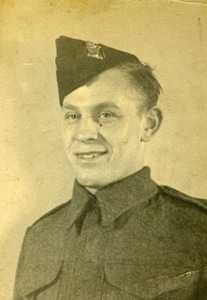
7022674 Fusilier
Percy Richard Childs
Ist Bn., Royal Irish Fusiliers
27th October 1943 aged 22.
Grave VIII D. 39.
Son of Ernest William and Minnie Childs, of Hackney, London.
Remembered by his nephew Peter Munton
Percy Richard Childs
Ist Bn., Royal Irish Fusiliers
27th October 1943 aged 22.
Grave VIII D. 39.
Son of Ernest William and Minnie Childs, of Hackney, London.
Remembered by his nephew Peter Munton

7951413 Trooper
David Sinclair
50th Royal Tank Regiment. R. A. C.
21st December 1943, aged 25.
Plot XIV. B. 23.
Son of David and Isabella J. Sinclair of St. Margaret's Hope, Orkney.
David Sinclair was born in Heads, South Ronaldsay on 20th January 1918. David trained as a draper in Kirkwall and Shetland, was manager of a draper shop in the RN base at Lyness when war broke out. David joined the Royal Tank Regiment in March 1942, served in its 50th Battalion in Tunisia during the close of the North Africa campaign. 50th RTR changed its Valentine tanks for Shermans before took part in the invasion of Sicily in July 1943. That was followed by landings on mainland Italy and advance up the Adriatic coast. 50th RTR lost 15 tanks (9 from mines) crossing the River Sangro in November. David's tank became bogged down as they advanced beyond on 21st December and its crew left it to try and reach wounded Indian soldiers. David Sinclair and another trooper were killed when one of them stepped on a mine, their tank commander was also wounded.
Words and image courtesy of George Esson
David Sinclair
50th Royal Tank Regiment. R. A. C.
21st December 1943, aged 25.
Plot XIV. B. 23.
Son of David and Isabella J. Sinclair of St. Margaret's Hope, Orkney.
David Sinclair was born in Heads, South Ronaldsay on 20th January 1918. David trained as a draper in Kirkwall and Shetland, was manager of a draper shop in the RN base at Lyness when war broke out. David joined the Royal Tank Regiment in March 1942, served in its 50th Battalion in Tunisia during the close of the North Africa campaign. 50th RTR changed its Valentine tanks for Shermans before took part in the invasion of Sicily in July 1943. That was followed by landings on mainland Italy and advance up the Adriatic coast. 50th RTR lost 15 tanks (9 from mines) crossing the River Sangro in November. David's tank became bogged down as they advanced beyond on 21st December and its crew left it to try and reach wounded Indian soldiers. David Sinclair and another trooper were killed when one of them stepped on a mine, their tank commander was also wounded.
Words and image courtesy of George Esson
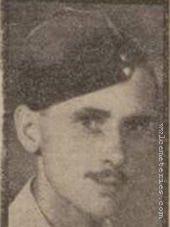
6014396 Private
Horace Wakeling
5th Bn. Essex Regiment
2nd November 1943, aged 23.
Coll. grave XIV. C. 33-35.
Son of Mr. and Mrs. J. Wakeling, of Great Waltham, Essex.
Horace Wakeling
5th Bn. Essex Regiment
2nd November 1943, aged 23.
Coll. grave XIV. C. 33-35.
Son of Mr. and Mrs. J. Wakeling, of Great Waltham, Essex.
Article provided by Andrew Lomas (Great nephew). Click on image to enlarge.




